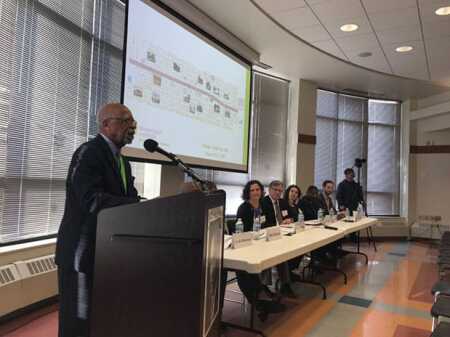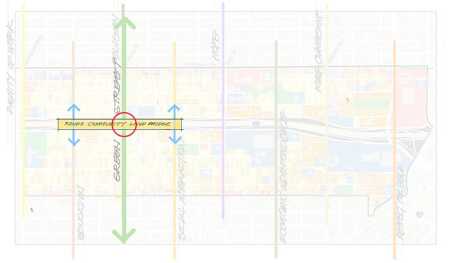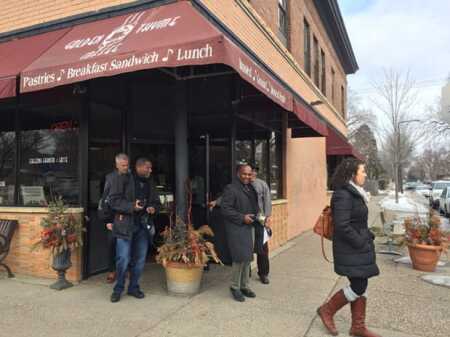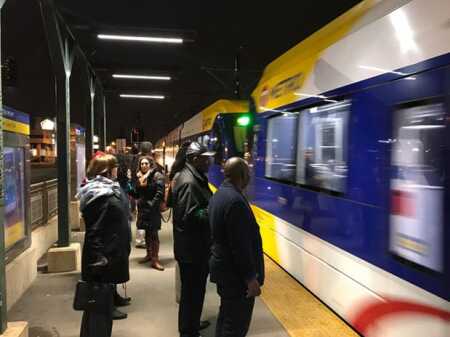ULI Advisory Services has presented their recommendations on a proposed Rondo Community Land Bridge in St. Paul—a project that is intended to build both a physical and symbolic bridge for the Rondo neighborhood. The proposed land bridge would cap Interstate 94 for several blocks between Lexington Parkway to Dale Street, while creating an opportunity to redevelop about 20 acres (8 ha) of land for new development in the urban neighborhood.
The panel’s recommendations are aimed at putting together a framework of detailed next steps to move the vision for the Rondo Community Land Bridge forward into the pre-development phase. ULI’s panelists recognized from the start that this would be an impactful project for the city of St. Paul and the African American community with supporters who have embraced the theme that this project is “more than a bridge.”
When plans to construct I-94 were taking shape in the mid-1950s, the decision was made to route the interstate through Rondo, which at the time was home to 85 percent of the city’s African American population. The interstate literally split the neighborhood in two, displacing more than 600 homes and places of business in the process.
ReConnectRondo is a neighborhood group spearheading the effort to make the bridge a reality. In the process, the organization aims to bring healing to the community, acknowledge the local culture and heritage, and create a new legacy to unite and elevate the neighborhood through economic development.
“What happened to Rondo shouldn’t have happened. We are here as a living testament and memory that if government and the community work together, the possibilities are immense,” says Marvin Anderson, chairman of ReConnectRondo. The organization was one of several sponsors for the ULI Advisory Services visit along with other partners that include the Minnesota Department of Transportation (MnDOT) and the city of St. Paul. The visit also is part of ULI’s participation in the 10-Minute Walk Campaign, a collaborative effort with the Trust for Public Land and the National Recreation and Park Association to increase access to urban parks nationwide.
“We believe that a significant Rondo Community Land Bridge should move forward. We think this is a remarkable opportunity to create 20-plus acres of new land that will be a significant economic development project for the region, for the city of St. Paul, and for this Rondo community,” says Lyneir Richardson, ULI leader and executive director for the Center for Urban Entrepreneurship and Economic Development at Rutgers University.
Significant “Healing” Scale
A group of experts representing ULI Advisory Services spent a week visiting Rondo, meeting with stakeholders, and interviewing members of the community to develop a proposal of recommended steps to take over the next 12 to 24 months. “The vision has momentum, but we all believe that now is the time for meaningful action steps and the seed funding to be put in place so that we get the bridge to the point of inevitability,” says Richardson.
The recommended first phase of the Rondo Community Land Bridge would be centered on Victoria Street and target several blocks along I-94 from Chatsworth Street North to Grotto Street North. ULI Advisory Services also recommends expanding the land bridge in the future west of Lexington Parkway North and east of Rice Street.
First and foremost, the Rondo Community Land Bridge is an opportunity to create an African American community commons, notes Bert Gregory, a ULI Advisory Services panel member and a partner at Mithun in Seattle. As the center of St. Paul’s African American community, the master plan should include a vibrant mix of uses including housing, food, arts, culture, business, and entertainment that are “catalyzed and stabilized” by anchor institutions, such as branch locations for higher education or health care, he says. The project also should create significant new community open space for St. Paul that supports a ten-minute walk to parks, community gatherings, and festivals, he adds.
The panel proposed three land use options that range from the creation of 350 to 1,400 housing units; 125,000 to 500,000 square feet (11,600 sq m) of commercial and community space; and 30 to 70 percent of open space. Master plan recommendations also include creating a Rondo Community Commons at Victoria; converting Victoria to a green street; and introducing bus, transit, and mobility improvements.
ULI Advisory Services recommends that MnDOT should take the lead in constructing and maintaining the land bridge, but there is a huge opportunity for the Rondo community to take a leadership role in shaping the project. “I think we can all agree that this is a legacy project. It is honoring the legacy of the community lost, and also creating a new legacy for generations to come,” says Beth Callender, a ULI Advisory Services panel member and principal of CallenderWorks in San Diego.
Important Next Steps
The first important step is to hire someone to spearhead fundraising with a target goal of raising $6 million in seed money to support a critical scoping phase. The seed money will help pay for cost estimating, feasibility studies, design, and engineering. Based on past land bridge projects, the cost per acre can range from $20 million to $50 million, notes Ilana Lipsett, ULI Advisory Services panel member and cofounder of Freespace in Oakland, California. “That is a huge differential. So, it is important to get together a scoping phase to look at what actual costs may be,” says Lipsett.
Fundraising will need to tap a full spectrum of public and private sources ranging from the city and state government, tax increment finance (TIF) money, grants to corporations, individuals, impact investors, and even crowdfunding.
In the near term, the task at hand is creating a buzz about the project, building awareness, and garnering more support both within the neighborhood and the broader community. To some extent, that will involve leveraging existing community events to promote the land bridge, such as the annual Rondo Days festival and Selby Avenue Jazz Fest. Longer term, it will involve integrating public art, culture, and events in the community space created by the land bridge.
Other key ULI recommendations for ReConnectRondo and its partners over the next 12 to 24 months include the following:
- Conduct comprehensive market and financial analysis. Prepare an affordable housing strategy to identify target income levels and unit types as well as policies and programs for affordable housing production and preservation to avoid displacement. Conduct an employment analysis to identify targeted industry sectors, as well as policies and programs for job generation and workforce training.
- Establish official boundaries for the Rondo neighborhood that will help raise awareness. In addition to simply elevating the visibility of the Rondo neighborhood, more formal boundaries will help pave the way to create overlay districts, such as a defined business improvement district (BID), a TIF district to fund community projects, and an arts and cultural district.
- Canvass the neighborhood to develop a database of residents’ housing status, including their ability to pay rent/mortgage and home improvements, to develop a true sense of displacement risks and to develop a funding plan to assist those who need help.
The ULI Advisory Services group also recognizes the real concerns around gentrification and displacement that the land bridge could create, notes Richardson. This is a huge project that comes with both challenges and opportunities, but it does have the potential to be a model for other communities. “If we figure out how to embrace the idea of the African American history and culture and interweave that with all that this project is meant to be, then it really will be an example that others will follow,” he adds.
ULI’s Advisory Services group included a group of nationally renowned land use and urban planning experts who made recommendations to the ReConnectRondo organization and its partners, which include the city of St. Paul, MnDOT, the Metropolitan Council, the Minnesota Department of Health, and Ramsey County. The full presentation of recommendations can be found here.









